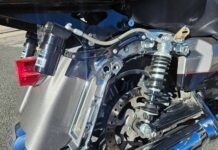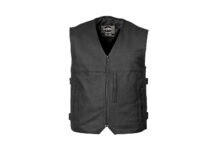Back when I first started riding, if I went out and both my brake light and headlight were working, I figured it a good omen. After all, 12-volt electrics were still in their infancy and an electric-start Harley was a novelty. That was the main reason they retained a kicker for so many years—backup for an unproven product. And although the mechanism was a confusing design involving a jackshaft, pivot lever and a cantankerous solenoid, the biggest problem was in the massive lead-plate battery that, despite its size, simply did not carry the cranking amps needed in many instances. This was especially true on cold mornings—or if your points were corroded, or your fuel system was dirty. It didn’t take much in the way of a stubborn V-twin to run down those old batteries. But over the years the technology has evolved to a supreme level with the Shorai lithium series of ultra light batteries leading the charge.

The Shorai LFX36L3-BS12 fits all FLH and FLT models from 1997–2013 and is literally dwarfed by the stock unit from my 2003 Road King. The width remains the same between the two (6.5″) but the diminutive Shorai measures a mere 3.5″ deep (compared to the OEM at 5.5″) and is only 6-1/8″ tall (while the stock lead-acid comes in at 7″). The contrast in weight mass is even more impressive with the petite Shorai weighing in at just under five pounds, while the H-D behemoth tips the scale at almost 22. That huge difference is achieved by the use of a completely different type of chemistry than the antiquated lead-acid battery, providing a much larger capacity and less than one-third internal resistance (resulting in increased efficiency), all wrapped up in a smaller package with a dramatic reduction in weight. That all translates into a whopping 540 cold cranking amps—quite an imposing figure.
Installation is forthright and simple (it’s just a battery) and can be accomplished by even the most inept home mechanic. Probably the most difficult part is hoisting the stock 22 lb. chunk of rubber and lead out of the bike’s battery compartment. The second hardest part is the installation of the “series” bar, a simple metal strip across two poles that completes an internal circuit. (This feature allows the LFX batteries to be legally shipped via ground or air services.) And that part isn’t really difficult, but… removing the plastic cover that hides the connection meant having to scrounge up a tiny jeweler’s screwdriver to tackle the four tiniest screws presently on my Road King. (The series bar connection and the terminal posts are all 10mm, same as the stock battery.)
After that you will need to decide what best suits your particular installation dependent on how your battery cables are routed. The basic Shorai lithium comes with flush-mounted terminals, but the kit includes a pair of L-brackets allowing the option of either side or front connections. The L-brackets come with nifty set screws that secure the brackets from spinning while installing. After that comes the needed install of the self-adhesive foam shims. Since the lithium battery is so much smaller than the stock item, the included foam spacers must be used to ensure a tight fit. After that, install your hot/positive leads first followed by all negative cable connections. Done.
The Shorai LFX batteries are charged to 60 percent of capacity when shipped so the recommended practice is to charge the battery before first use. I didn’t read that part in the instructions and fired it right up without any problems.
The company states that down to about 20 degress Fahrenheit most users find they can start their bike on the first crank. Completely contrary to common understanding, Shorai actually recommends leaving the lights on for a few minutes initially in cold weather conditions to “wake the battery,” which will result in a superior first crank. If for any reason the bike does not fire up immediately, that first crank has “warmed” the battery and the second attempt will be much stronger (bizarre technology for sure and something I simply do not understand).

I installed my LFX just before leaving for Sturgis in 2012. It has performed well despite enduring all manner of tortuous rain, cold and heat. While covering more than 15,000 miles, without fail that stock little 88” has always spun like a top. The Road King recently went through a rough time mechanically and sat in the shop for three months without being started. I recently chose the coldest day of a Texas winter (36 degrees) to see if there might be an issue with cranking. No problems were encountered despite the long interval between starts. But I did notice that some of the foam had compressed during the previous year of abuse and that the case was a little loose inside the battery compartment. That’s an easy fix since Shorai includes an abundance of foam shims and I seldom throw anything away. Without a doubt this is the best battery purchase I’ve ever made.
Shorai also produces batteries for personal watercraft, ATVs, scooters and even riding lawn mowers. And although it’s a pricey alternative, it’s the tab you pay for high-tech innovation. And the peace of mind it brings to the table trumps any invoice or the possibility of having to park on a tall hill and hoping for a rolling start on a frosty morning. Gentlemen, start your engines.



















